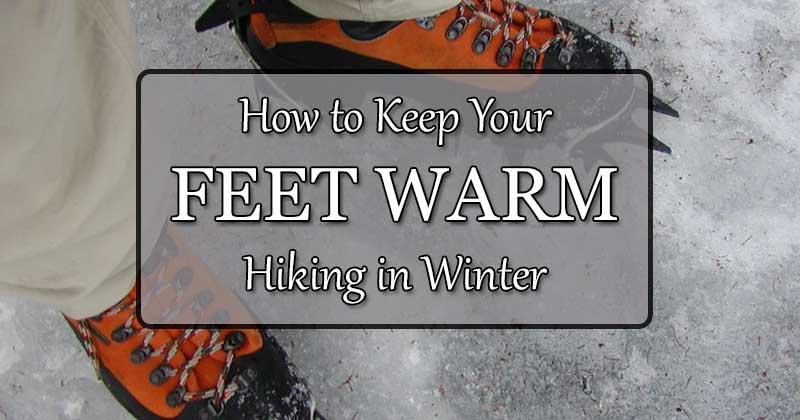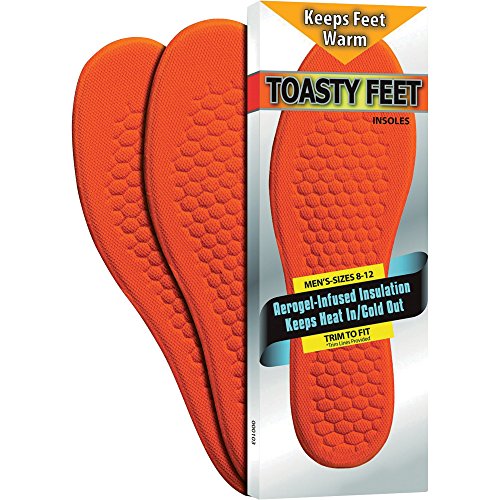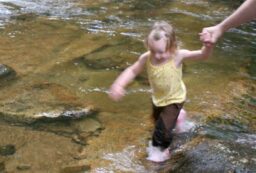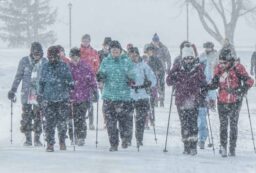Hiking in winter with cold toes and feet isn’t just a miserable experience, it can be downright dangerous. When your feet get cold, the blood vessels get smaller and less blood flows to them. If you aren’t able to warm your feet, permanent damage can occur – including severe frostbite that results in amputation.
Keeping your feet warm while hiking in sub-freezing weather isn’t that difficult though. It’s just a matter of following some basic “rules.” You don’t even necessarily have to buy expensive winter hiking gear if you follow these rules. Here they are!
1. Wear Layers on Your Feet Too
Just like you need to wear layers of clothing on your body and hands too, you also need to wear layers on your feet. A winter foot-layering system should consist of:
- Moisture-wicking layer: Such as a thin silk, synthetic or thin wool sock
- Light insulation layer: Such as a lightweight wool sock
- Heavier insulation layer: Such as a midweight or heavyweight wool sock. Some winter boots have built-in insulation which serves as this layer.
- Shell layer: The shell layer is your boot. It should protect against wetness and wind.
2. Invest in Good Socks
Often there isn’t much of a difference between an expensive hiking jacket and a cheap one. However, there is a huge difference between a cheap $3 pair of socks and $20 socks. Some of the really good pairs of winter socks cost even more but they are really worth it for keeping your feet warm.
Some of the best winter hiking socks are by:
- Darn Tough: overall the best winter hiking socks, according to serious hikers. Get them at the Darn Tough website or Amazon

- Wigwam: Get on Amazon

- SmartWool: Get on Amazon

- Fox River: Get on Amazon

- DeFeet Woolie Boolies: Get on Amazon

*When buying winter hiking socks, make sure you pay attention to the weight of the sock (thickness) and also the size. You’ll need to size up the outer layers of socks so they don’t compress your feet. Which brings us to…
3. Don’t Compress Your Feet
If your socks or boots are too tight, it will restrict circulation to your feet and make them get cold. A lot of hikers realize they need a larger sized boot for winter, but forget that they need larger size socks too.
For example, my first layer of socks is my normal Medium fit. The second layer is a Large size so it can go over top of the first without cutting off circulation. The third sock is an XL.
You should be able to wiggle your toes easily inside the boot, even with all of these layers on. That usually means getting a boot at least one size larger than you normally wear. Sorry, but you won’t be able to wear your fall hiking boots in winter without cutting off circulation.
Also avoid lacing up your boots too tightly as this will cut off circulation. You can even try different lacing methods to improve foot circulation for winter hiking.
4. Wear Waterproof Boots
While I personally don’t like waterproof hiking boots for summer (when breathability is a bigger concern), waterproof boots are almost always mandatory for winter hiking.
Even if the temperatures are above freezing, you still probably have to deal with sleet, melting snow, and other wetness when hiking. Your boots will absorb all this moisture and get your feet wet.
When the temperatures are below freezing, you still need waterproofing. Otherwise snow will get on top of your boot, melt from your body heat, and cause the boots to get wet. The boots can then freeze solid. For extreme temperatures, you’ll need a more reliable waterproof layer, such as winter boots with a rubber bottom.
*Some people wear trail runners, mukluks or other non-waterproof boots in winter. However, this is only safe if you can be sure your insulating socks won’t get wet, such as if the conditions are completely dry or you wear a waterproof layer over your insulating socks.
5. Know When to Wear Insulated vs. Non-Insulated Boots
Proper winter hiking boots have a layer of insulation inside. They do a great job of your feet warm in extremely cold weather.
However, insulated hiking boots generally aren’t a great idea for milder temperatures. The insulation can keep your feet too warm, causing your feet to sweat. Since the waterproofing traps the moisture, your feet end up getting wet from the inside out.
The bottom line? For hiking in temperatures down to around 20F, choose non-insulated boots. Make sure they are sized large enough to wear multiple layers of warm wool socks. For hiking in temperatures below 20F or if you will be standing around inactive a lot (or sledding, building a snowman…), choose insulated boots.
6. Use VBLs in Extreme Weather
A big problem with insulated boots is that your feet will start to sweat in them. The sweat will cause the insulation to get wet, which in turn gets your feet wet and dangerously cold. To keep the insulation dry, you should use a vapor barrier liner (VBL).
VBLs are simply a waterproof layer that keeps sweat from getting to the insulation. Because they aren’t breathable, VBLs are only recommended in very cold weather (approximately 15F or colder). If you use a VBL in warmer weather, your feet will probably get too sweaty and end up drenched.
Never wear the VBL right up against your skin. Here’s what a VBL layering system should look like in winter:
- Liner sock
- VBL
- Insulating wool sock
- Boot insulation
- Waterproof boot
What makes a good vapor barrier liner for feet?
The cheapest option is to just use plastic bags. However, I find that they tear really easily. Better options include:
- Oven roasting bags (like ones made by Reynolds)
- Bread bags
- Waterproof socks (remember to size up so they don’t squeeze your feet)
- Vapor barrier socks
7. Get Thermal Insoles
If you can’t afford good winter boots right now, one cheap way to make your current boots winter is to upgrade the insoles. Simply swap out the existing insoles for ones made out of insulating foam, wool, “AeroGel” or foil. If you want to get really fancy, you can even get heated insoles.
- Made with Aerogel infused insulation to keep heat in and cold out
- Toasty Feet also keep feet cool on hot surfaces
- Provides a thermal barrier of protection for your feet
8. Get Feet Off the Ground
Whenever you stop for a break, try to get your feet off the ground and especially off any snow. Otherwise the ground will suck the heat out of your feet quickly. Stand on a rock, fallen log, etc. instead. If you know you will be standing around a lot, consider bringing an insulating pad to stand on.
9. Don’t Put On Boots Until You Are Ready to Hike
You don’t want your feet to start sweating before you begin hiking. So, avoid putting on all those layers of socks and insulating boots until you are ready to hike. For example, you might want to wear different socks and sneakers while driving to the trail head and only then put on your feet layers.
10. Keep Core Warm
The body prioritizes organs for heating. So, if your core gets cold, your body will constrict blood vessels in your hands and feet (vasoconstriction). This can lead to frostbite. Thus, one of the best ways to keep your hands and feet warm in winter is to make sure your core is warm.
11. Have a Contingency Plan
It’s always smart to have a contingency plan when hiking but even more important in winter. Make sure your plan includes a way to prevent or treat frostbite if your extremities start getting dangerously cold.
Your contingency plan may include:
- Chemical toe warmers like these
- Extra pairs of socks, in case the ones you are wearing get wet
- Backup shoes in your car or for at camp if you are overnighting
Most importantly, don’t let your ego get the better of you. If your hands and feet get too cold, turn back! It’s better to end your hike early than end it in the emergency room.
Getting outdoors in winter? You’ll also want to read:
- Essential Winter Hiking Tips
- How to Keep Your Water Bottle from Freezing
- Hiking with Babies and Little Kids in Cold Weather
- Winter Camping Checklist
Image credit: “P1010004” (CC BY-NC-SA 2.0) by welcometoalville
Resources:
https://www.reddit.com/r/Ultralight/comments/cwndij/keeping_feet_warm_in_cold_weather/
https://www.reddit.com/r/CampingandHiking/comments/5l8q22/keeping_feet_dry_and_warm_when_hiking_in_winter/
https://sectionhiker.com/vapor-barrier-socks-using-reynolds-oven-bags/
https://www.reddit.com/r/Frugal/comments/e428e/frugal_how_do_you_keep_your_feet_toasty_in_the/
https://www.backpacking.net/forum/ubbthreads.php?ubb=showflat&Number=126002
https://workingperson.me/insulated-or-non-insulated-boots/#:~:text=In%20a%20rainy%20climate%2C%20non,definitely%20the%20way%20to%20go.
https://www.reddit.com/r/CampingGear/comments/dnxjlk/recommendations_for_insulated_winter_hiking_boots/
http://www.atmo.arizona.edu/students/courselinks/fall12/atmo336/lectures/sec1/comfort.html
https://opentextbc.ca/anatomyandphysiology/chapter/24-6-energy-and-heat-balance/
https://www.hunttalk.com/threads/insulated-boots-or-just-carry-warmer-socks.277168/















Post your comments